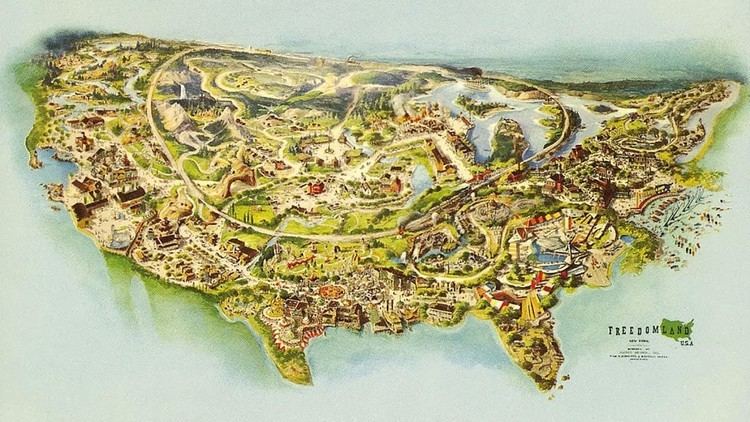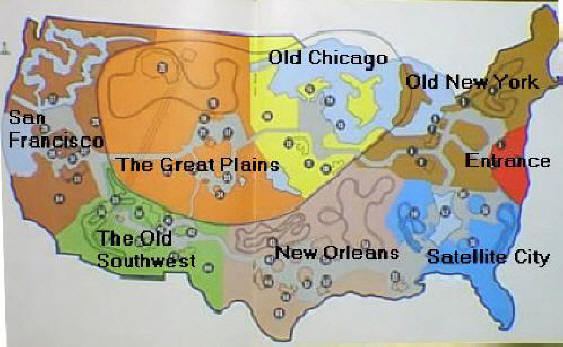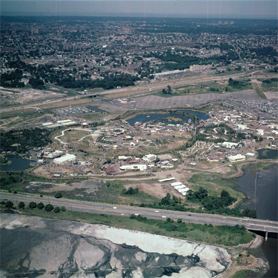Total 28 Opened 19 June 1960 Area 34 ha | Water rides 6 Closed 1964 Owner C. V. Wood Roller coasters 1 | |
 | ||
Slogan The World's Largest Outdoor Family Entertainment Center Similar Pleasure Island, Palisades Amusement Park, Adventureland, Playland, Great Escape | ||
Freedomland U.S.A. (usually called just Freedomland) was a short-lived, American history-themed amusement park in the Baychester area in the northeastern part of the Bronx borough in New York City. Its slogan was "The World's Largest Entertainment Center" (later, "The World's Largest Outdoor Family Entertainment Center").
Contents
- Connections to Walt Disney
- Construction and opening
- Themed areas and attractions
- Little Old New York 18501900
- Chicago 1871
- The Great Plains 18031900
- San Francisco 1906
- The Old Southwest 1890
- New Orleans Mardi Gras
- State Fair Midway added in 1962
- Additional areas never constructed
- Failure and demolition
- Surviving rides
- References

Freedomland opened on June 19, 1960. It closed at the end of the 1964 season when it failed to make a profit, and the land was used to build Co-op City.

Connections to Walt Disney

Freedomland was conceived by Cornelius Vanderbilt Wood (1920–1992), a young Texan who had previously worked in the planning, construction, and management of Disneyland. Hired by Walt Disney in 1953, Wood was the person who selected the orange grove site in Anaheim, California, where Disneyland was eventually built. Wood became very close to Disney during the next two years, but eventually the two men had a falling out. Reasons for this are unclear, but three theories exist: Wood was embezzling money from the park; Wood was taking too much public credit for Disneyland; or Wood had betrayed Disney by planning his own amusement parks, effectively stealing Disney's original concept. However, by January 1956, Wood had been fired from Disneyland. To this day, The Walt Disney Company refuses to acknowledge any role played by Wood in the creation of the first Disney theme park.

In 1956, the 36-year-old Wood began planning and building three of his own amusement parks across the country. In 1958, Wood opened Magic Mountain near Denver (closed in 1960 but revitalized in Southern California in 1971), Pleasure Island in Wakefield, Massachusetts, in 1959 (closed in 1969), and finally Freedomland in 1960. Wood's partner was Milton T. ("Ted") Raynor, a television sports producer and attorney, who served as Freedomland's president.
Construction and opening
The park's original concept was history-based and the layout was arranged in the shape of a large map of the contiguous United States with guests entering at the approximate location of Washington, D.C. Baychester Avenue at the park's western edge (roughly) represented the border with Canada. Freedomland was divided into different themed areas based on the history of the United States, each with its own attractions, shops, and restaurants. This made Freedomland a true theme park with one real theme. The research and design team consisted of 200 top artists and architects, including 19 Academy Award nominees. Original music for the park was written by Jule Styne, composer of many Broadway musicals, including Gypsy and Funny Girl.
Groundbreaking ceremonies for Freedomland took place on August 26, 1959. On March 24, 1960, six unfinished buildings were demolished by fire and had to be razed. Freedomland was built on the site of a former municipal landfill. Although the property was spread out over 205 acres (0.83 km2), the actual amusement park itself was just 85 acres (340,000 m2) – larger than Disneyland's 65 acres (260,000 m2). The park could accommodate 32,000 visitors at one time (90,000 during the course of a day) and boasted 8 miles (13 km) of navigable waterways and lakes, 10,000 newly planted trees, 18 restaurants and snack bars, and parking for 72,000 cars. It cost $65 million to build. The area was a swampy one connecting the Hutchinson River and the drainage into Westchester Creek, and was not entirely filled. This led to a profusion of mosquitoes during much of the season. The swampy bottom would later complicate the construction of the Co-op City housing complex on the site. The construction of Freedomland and subsequent construction of Co-op City have contributed to large areas of salt marsh degradation.
On June 18, 1960, Freedomland was dedicated in a ceremony with 5,000 people in attendance. The following day, June 19, the park officially opened with 65,000 visitors. That same evening, The Ed Sullivan Show presented a promotional tour of the park and referred to it as Disneyland's equal on the East Coast. By June 20, the second day of operation, Freedomland was forced to stop selling tickets because of traffic jams leading to the park. Freedomland's operating hours were from 9:30 a.m. until midnight (later 10 a.m. to midnight), seven days a week, from May through October. The Moon Bowl was also opened for occasional off-season performances.
Themed areas and attractions
Freedomland opened with seven different themed areas (later expanded to eight), each representing a location and era of U.S. History. They were:
Little Old New York (1850–1900)
Chicago (1871)
The Great Plains (1803–1900)
San Francisco (1906)
The Old Southwest (1890)
New Orleans-Mardi Gras
Satellite City-The Future
A moving cable bucket ride, with several buckets, took people over the Rockies from the US South-west to the Canada–US border.
State Fair Midway (added in 1962)
Additional areas (never constructed)
Failure and demolition
In its opening season Freedomland had already begun to run into major problems, both financially and otherwise. On June 25, 1960, almost a week after the park opened, a stagecoach overturned in the Great Plains section of the park, injuring ten people. Three of the victims were hospitalized, including one with a snapped spine. The park initially denied any responsibility until a visitor publicly released a photograph of the accident. Eventually, the injured parties filed lawsuits against the park. Two months later, on August 28, 1960, the front office was robbed of $28,836 by four armed men, who escaped in a boat. They were caught two weeks later and jailed the following year.
By the end of the 1961 season, Freedomland was already $8 million in debt. As it struggled to break even, the theme of the park was changed in an effort to appeal to more teenagers. The history exhibits and events would be joined by more conventional amusements, such as bumper cars, roller coasters, fireworks displays, and concerts, which broadened the appeal of the park. These changes resulted in a lawsuit. On September 5, 1962, Benjamin Moore, a paint company that sponsored an exhibit in Satellite City, sued Freedomland for $150,000 in damages. The company wanted to void their lease for their exhibit space, owing to "historical and educational" changes to the park's character. The suit was later dismissed.
On September 14, 1964, citing competition from the 1964 New York World's Fair, Freedomland filed for bankruptcy and was torn down. This remains a questionable reason since the World's Fair would be finished after 1965. There is a more conspiratorial explanation to the demise of Freedomland, however. Some sources speculate that powerful New York City real estate magnate William Zeckendorf developed Freedomland along with Vanderbilt with an original intent of converting the 400-acre (160 ha) plot into what would become an enormous cooperative housing complex. By demonstrating that large structures could operate on the converted marshland without having incurred damage or settling problems, the developers became eligible for property variances that greatly accelerated a 15-to-20-year planning period before construction could proceed. Quick profits would be gained by the sale of the land for the Co-op City housing development that would be built mostly on Freedomland's parking lot.
Freedomland filed for bankruptcy and was torn down starting in late 1965 as the park stayed closed for the 1965 season. Interestingly, Freedomland was built at a time when the traditional New York City amusement area of Coney Island was in a state of continuing decline; in the year that Freedomland closed, in 1964, Coney Island's last integrated amusement park, Steeplechase Park, was also shuttered.
The site of the former park is now occupied by the large residential development Co-op City and the Bay Plaza Shopping Center. In 2013 a plaque commemorating the park was installed near its one-time entrance.
Cornelius Vanderbilt Wood died in March 1992. Ironically, the Walt Disney Company opened up an area of nightclubs at the Walt Disney World Resort in Bay Lake called Pleasure Island, which was the same name as Wood's most successful amusement park.
Surviving rides
Many of the Freedomland rides and attractions were sold to other parks and relocated.
